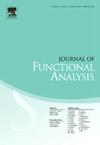Murray–von Neumann dimension for strictly semifinite weights
IF 1.7
2区 数学
Q1 MATHEMATICS
引用次数: 0
Abstract
Given a von Neumann algebra M equipped with a faithful normal strictly semifinite weight φ, we develop a notion of Murray–von Neumann dimension over that is defined for modules over the basic construction associated to the inclusion . For a faithful normal tracial state, this recovers the usual Murray–von Neumann dimension for finite von Neumann algebras. If M is either a type factor with or a full type factor with , then amongst extremal almost periodic weights the dimension function depends on φ only up to scaling. As an application, we show that if an inclusion of diffuse factors with separable preduals is with expectation and admits a compatible extremal almost periodic state φ, then this dimension quantity bounds the index , and in fact equals it when the modular operators and have the same point spectrum. In the pursuit of this result, we also show such inclusions always admit Pimsner–Popa orthogonal bases.
严格半有限权的Murray-von Neumann维数
给定一个具有忠实正规严格半有限权φ的冯·诺依曼代数M,我们发展了(M,φ)上的murray -冯·诺依曼维的概念,该概念是为与包含Mφ∧M相关的基本构造上的模定义的。对于φ=τ是一个忠实的正态跟踪状态,这恢复了有限冯诺伊曼代数的通常的Murray-von Neumann维数。如果M是具有0<;λ<;1的III1型因子或具有Sd(M)≠R的完整III1型因子,则在极值概周期权值中,维数函数仅依赖于φ直至缩放。作为应用,我们证明了如果具有可分离前模N∧M的扩散因子的包含具有期望E,并且允许相容的极值概周期态φ,则该维数限定了指标IndE,并且当模算子Δφ和Δφ|N具有相同的点谱时,实际上等于它。在追求这一结果的过程中,我们还证明了这种包体总是承认Pimsner-Popa正交基。
本文章由计算机程序翻译,如有差异,请以英文原文为准。
求助全文
约1分钟内获得全文
求助全文
来源期刊
CiteScore
3.20
自引率
5.90%
发文量
271
审稿时长
7.5 months
期刊介绍:
The Journal of Functional Analysis presents original research papers in all scientific disciplines in which modern functional analysis plays a basic role. Articles by scientists in a variety of interdisciplinary areas are published.
Research Areas Include:
• Significant applications of functional analysis, including those to other areas of mathematics
• New developments in functional analysis
• Contributions to important problems in and challenges to functional analysis

 求助内容:
求助内容: 应助结果提醒方式:
应助结果提醒方式:


